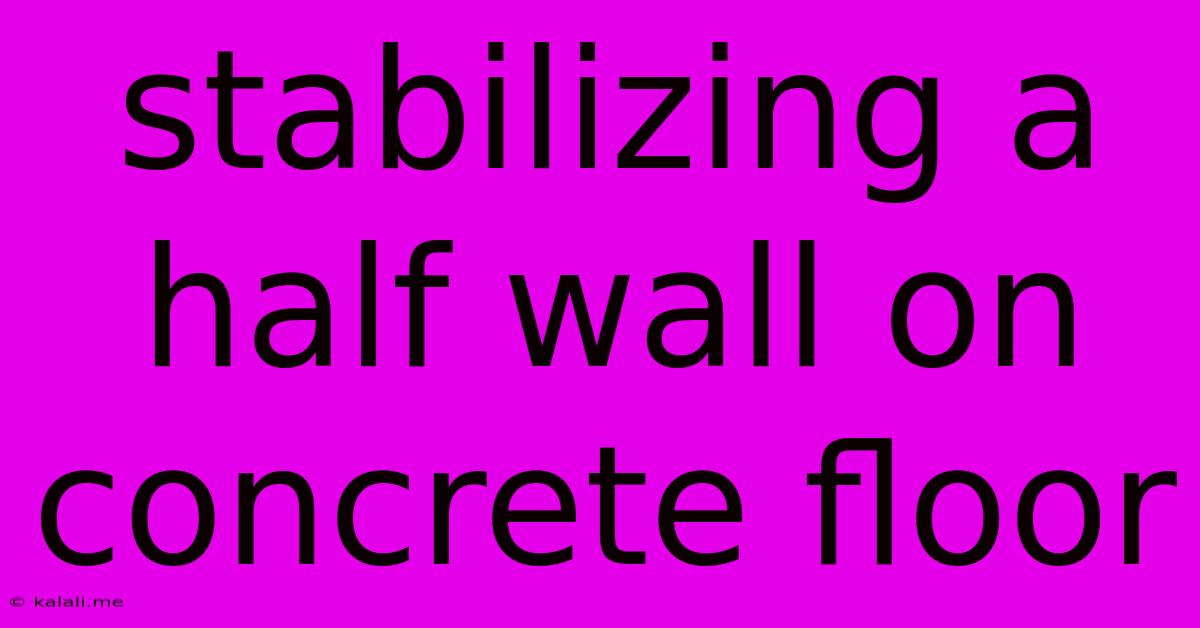Stabilizing A Half Wall On Concrete Floor
Kalali
May 24, 2025 · 3 min read

Table of Contents
Stabilizing a Half Wall on a Concrete Floor: A Comprehensive Guide
Meta Description: Learn how to effectively stabilize a half wall on a concrete floor, covering various methods, materials, and crucial considerations for a secure and lasting installation. This guide provides practical steps and expert advice for DIYers and professionals alike.
Building a half wall, whether for aesthetic reasons or to create functional spaces, is a popular home improvement project. However, ensuring its stability, especially when resting on a concrete floor, requires careful planning and execution. This article will explore several methods for stabilizing a half wall on a concrete floor, outlining the necessary materials and steps to achieve a secure and long-lasting installation.
Understanding the Challenges
Before diving into solutions, let's understand why stabilizing a half wall on concrete needs extra attention. Concrete floors, while sturdy, can present unique challenges:
- Uneven Surfaces: Concrete floors are rarely perfectly level. Slight inconsistencies can lead to a wobbly half wall, compromising its structural integrity and overall appearance.
- Movement and Settlement: Over time, concrete can settle or shift slightly, potentially causing stress on the half wall's foundation.
- Lack of Anchoring Points: Unlike walls built directly into framing, half walls on concrete floors need alternative anchoring methods.
Methods for Stabilizing a Half Wall
Several methods effectively address the challenges of stabilizing a half wall on concrete. The best approach depends on the half wall's size, design, and the specific characteristics of your concrete floor.
1. Using Concrete Anchors
This is a robust solution, particularly for heavier half walls. Concrete anchors, such as expansion anchors or wedge anchors, are drilled into the concrete floor and provide strong points for attaching the wall's base.
- Materials: Appropriate size drill bit, concrete anchors, appropriate fasteners (screws or bolts), level, masonry bit.
- Process: Drill pilot holes into the concrete, insert the anchors, and securely fasten the wall's base to the anchors. Ensure the wall is plumb and level throughout the installation process.
2. Employing a Concrete Base Plate
A sturdy base plate, usually made of metal or pressure-treated lumber, distributes the half wall's weight across a wider area of the concrete floor. This minimizes the risk of localized stress and enhances stability.
- Materials: Metal or pressure-treated lumber base plate, appropriate fasteners, level, shims (if needed).
- Process: Secure the base plate to the concrete floor using concrete anchors or heavy-duty adhesive. Then attach the half wall's base to the securely mounted base plate. Shims can be used to adjust for unevenness in the concrete floor.
3. Utilizing Construction Adhesive
For lighter half walls, construction adhesive offers a simpler, potentially less intrusive option. High-quality adhesive creates a strong bond between the wall's base and the concrete floor.
- Materials: High-quality construction adhesive, caulk gun, level, possibly shims.
- Process: Apply a generous bead of adhesive to the bottom of the half wall's base, ensuring even distribution. Carefully position the wall and firmly hold it in place until the adhesive sets. This method may require additional support until fully cured.
4. Combining Methods for Enhanced Stability
For ultimate stability, especially with larger or heavier half walls, combining methods is often recommended. For example, you could use concrete anchors in conjunction with a base plate for superior support.
Important Considerations
- Wall Weight and Material: The weight of your half wall significantly impacts the required stabilization method. Heavier materials like brick or stone necessitate more robust anchoring.
- Concrete Condition: Assess the condition of your concrete floor. Cracks or significant imperfections may require additional steps to ensure a stable foundation.
- Local Building Codes: Always comply with local building codes and regulations regarding wall construction.
By carefully considering these factors and selecting the appropriate stabilization method, you can ensure that your half wall stands strong and beautiful for years to come. Remember, safety is paramount. If you are unsure about any aspect of the installation process, consult a qualified contractor.
Latest Posts
Latest Posts
-
Z Is For Zachariah Movie Ending
May 25, 2025
-
How Do You Stop A Text From Sending
May 25, 2025
-
Missing From Clause Entry For Table
May 25, 2025
-
Can You Get A Dui In A Wheelchair
May 25, 2025
-
Can You Transport Water Heater On Its Side
May 25, 2025
Related Post
Thank you for visiting our website which covers about Stabilizing A Half Wall On Concrete Floor . We hope the information provided has been useful to you. Feel free to contact us if you have any questions or need further assistance. See you next time and don't miss to bookmark.